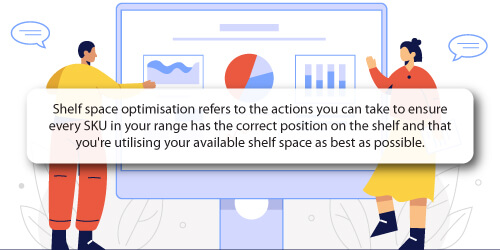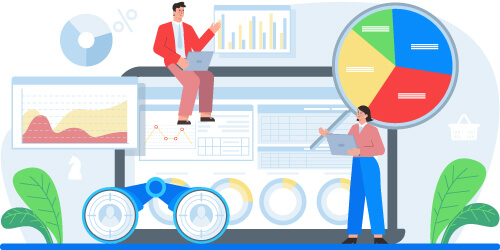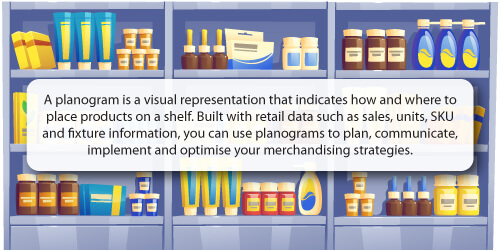If you are a supplier worth your salt, you need to know how to optimise the shelf space* given to you. Why? Because that makes you the type of supplier a retailer wants to work with regularly. And who can blame them? By optimising the space given to you in-store, you're ensuring that you both benefit. But how can you ensure effective shelf space optimization?
That's where planograms play a vital role.
Unfortunately, not all retailers have access to specialist space planning software. But that’s an opportunity for you. By building planograms using DotActiv software, you can offer guidance in new store openings, revamps or during category refresh periods. More importantly, adding the relevant data to the software, you can motivate them to allocate more space to your brands.

What is shelf space optimization?
Before we can talk about planograms and why they’re worth the effort, it’s critical to understand shelf space optimisation for what it is.
What is shelf space optimization?

You usually complete such an exercise using all the necessary data. Why?
Using the relevant retail data helps you determine the correct basic range that should go into all stores, and the correct number of facings. That ensures that you don’t struggle with stock returns or shortages after delivering stock to stores. Doing so also creates even stock replenishment opportunities.
As for why you should pay attention to shelf space optimization, there are a few reasons.
1. Not optimising your shelf space can lead to underfaced products
You can link shelf optimization to your sales, revenue and profit. If you don’t optimise your space - not positioning your SKUs correctly on the shelf or giving them the space they deserve - it will lead to the issue of under-facing your products. That leads to gaps on your shelf.
That’s not only a possibility but a certainty, which will in turn, give shoppers the impression that the store (your retail client) can’t provide them with the products they need.
2. Not optimising your shelf space can lead to overfaced products
The opposite is also true. You can also overface your products, which means you have too many products on your shelf. The consequences of this are just as severe as those attributed to underfacing your products.
For retailers, this includes:
- Struggling with excess inventory. Items that aren't selling as well as you'd hope to take up shelf and storeroom space, which retailers could use for products that bring in sales and profit.
- Losing out on full-price sales. When items aren’t selling, retailers need to place them on sale to recoup any lost money.
For suppliers, this can harm your reputation as well as the relationship that you might have built with your retail client.
When optimising your shelf space, you ensure your retail client has the right amount of stock on hand. It also leads to even days of supply (DOS) for all of your products on the shelf.

What data do suppliers need to optimise their shelf space?
We’ve already mentioned the need for retail data when optimising your shelf space. But what type of data is needed? Below, we unpack the most relevant data that you would need to optimise your shelf space effectively.
1. Sales data
First would be your point of sale (POS) data. This is the raw sales data from your retail client.
The POS data would need to include sales data for your products as well as that of your competitors in the category over a specific period. That is so you can analyse it and then use the output to create an accurate data-driven planogram for the category. This allows you to learn if there has been any growth or decline in a particular category.
It also allows you to see the days of supply and weekly movement of each SKU, which can aid your future replenishment efforts. If you are looking for ways to get access to the sales data of your retailers, there are a few actions you can take to convince your retail clients.
2. Market data
Besides sales data, you also need market data. The fact that you likely have multiple retail clients means it’s easier to obtain such data than it is for your retail clients. It's time to use it.
Market data includes information such as target market, geographic location and how this influences target market demographics.

Depending on which areas you focus on, be it nationwide or specific regions, you can determine which gondola information you'll need. This is important to create a range catering to each market.
You can also access market data through third parties who specialise in collating and distributing such retail data. What you choose, however, does depend on your budget.
3. Shelf space data
Without access to accurate data on the available shelf space, you’ll struggle to build an effective planogram.
This data type would include the following:
- Drop counts per cluster,
- Size of the gondolas (height, width and depth)
- Base heights of each gondola in store.
Once you have this information, you can be confident that you’ll build an accurate planogram. More importantly, you’ll be confident when presenting your final planograms to your retail client.
4. A range
You also need a basic but complete range per cluster with a range cap. It's essential if you have limited space on certain gondolas.
By having a set core range, you know which products are generating the most sales. It also allows you to cater for different clusters and demographics by adding certain products to specific retail stores.
A benefit of a core range is to test new products to learn if they sell. If they do, you can add them to your assortment.
5. Product data
After receiving the set range, you will need to source the information on each of your SKUs.
For every SKU, you should include the correct product code, barcode and description in the range list. Then, you need a front-facing HD image with a white background and the dimension of each product (height, width and depth).
If you do not have this or the correct gondola dimensions, you'll struggle to build accurate shelf plans. You can attempt to create planograms, and they may look good visually. However, when implementing them, you could run into serious problems.
A few issues could include having gaps on the shelf or products not filling their allocated space.
6. Merchandising principles
After receiving the ranges, sales, market and product data, it’s time to discuss your merchandising principles.
Your space planner (or one from a third-party service provider such as DotActiv) must understand your goals and objectives.
For example, they must know what to do with new or innovative lines when they appear. With the retail data and context around everything else, they can build data-driven planograms that consider your shelf space.
The shelf space and location on the gondola must also be kept in mind when you apply your merchandising principles.

How can suppliers use planograms to optimize shelf space?
When optimising your shelf space, you can look at any previous merchandising principles used and learn whether or not you have allocated enough space to your brand. You can then rebuild your planograms using the collected data, updated merchandising principles and your goals and objectives.
That means optimising your shelf space. But how can you use planograms to do that?
1. Allocate the correct shelf space to each product
If your products deserve more space, you can allocate that to them. Using your collected data, you have evidence for why your products deserve it.
The benefit of planograms is that they are an excellent tool for visualising how you plan to merchandise your products in the space given to you by your retail client. You'll also know how your products look together with every other product in the category.
2. Optimise the flow of each gondola
You can also use planograms to optimise the flow of each gondola.
Doing this allows you to ensure that you follow the recommended flow and merchandising principles and implement them correctly in each cluster or store. You can also use it to allocate enough facings to each SKU.
If an SKU doesn’t deserve the space (based on your sales data), you can remove it and replace it with a product that deserves the space.
3. Use planograms to grow categories
Building planograms as a supplier isn’t only for the benefit of your products. If the retailer has entrusted you to act as the category captain, you’re responsible for the entire product grouping.
Thus, while optimising the shelf space for your products, you’re simultaneously doing that for every other product to grow the category.
That means the retailer benefits from an increase in sales too, which leads to our next point.
4. Build and develop mutually beneficial relationships
While not a direct way to optimise your shelf space, it is worth mentioning that you can use planograms to build and develop mutually beneficial partnerships with your retail clients.
It leads to greater trust when making decisions or building future planograms.
If a retailer questions you, you can show them your reasoning for building planograms a certain way by showing them the data. In doing so, you can show you’re optimising the space for their shelf. You’re simultaneously benefitting because you’re ensuring your products get the space they deserve so you can profit too.

Conclusion
Shelf space optimisation has so much to offer you. You can use it as an opportunity to increase awareness of your brand or products, and increase your sales, while also building relationships with your retail clients.
That means that as a supplier, there is no argument against attempting that. More importantly, it’s a no-brainer to use planograms to help you achieve that.
Looking for advice or need a category management solution that can help you improve your business? Why not book a complimentary consultation with a DotActiv expert here to hear how we can help you with these goals and more? You can also browse our software and service options on our online store here.



